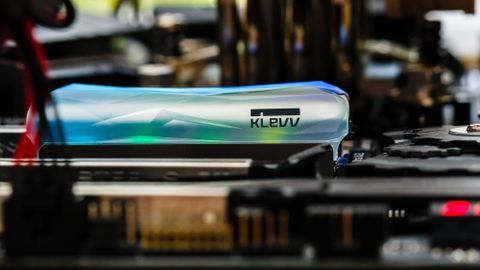Why you can trust Tom's Hardware
Klevv’s CRAS C700 RGB is currently the company’s fastest and coolest-looking SSD. With an entry-level NVMe controller powering it, however, there was no way that it would be topping our leaderboards. Like most RGB SSDs, Klevv’s CRAS C700 RGB performs on the lower end of the spectrum. But that doesn’t mean you should totally disregard it.
In testing, the CRAS C700 RGB’s game load performance results ranked up there with some of the best. Under both consumer and prosumer-based workloads alike, the CRAS C700 RGB kept up and even surpassed WD’s Blue SN500 throughout testing. It seems SK Hynix’s 72L NAND flash is fairly competitive when paired with the right controller and firmware mix.

With a small SLC cache and some extra over-provisioning, the CRS C700 RGB’s base write performance degraded to a respectable 795 MBps after the SLC cache filled. But compared to other drives that small 12GB cache did hurt it a bit under our 50GB file copy workload.
Instead of pure speed, the company focused on sustained performance and creating a unique look with attractive lighting effects that can help to set off most builds. Being an M.2 drive, without the need for a SATA data and power cable, you can build a cleaner system with less cable clutter, too. But with such a thick design, you won’t be able to stuff it behind your GPU. So be sure you have a spare NVMe M.2 slot on your board that isn't blocked by other components or a heat shield.
Also, while the large heatsink and RGB based design set it off aesthetically, it is due to the addition of RGB lighting that power efficiency results came in low. That’s the price you have to pay when you want to see all those RGB lights twinkle and shine. And the light show here is quite nice. If you're looking for a unique RGB SSD for your next build, be sure to give it a look -- that is if you can find it for sale in your region.
MORE: Best SSDs
MORE: How We Test HDDs And SSDs
MORE: All SSD Content

Sean is a Contributing Editor at Tom’s Hardware US, covering storage hardware.
-
tennis2 RGB has gone too far. It wasn't even good on a 2.5" SSD (causing overheating and performance degradation) let alone on a M.2 SSD which are known for running hot/overheating without all that extra BS.Reply -
hotaru251 Reply
my issue isnt that it exists on everything...but that you HAVE to have it on majority of stuff on premium side...tennis2 said:RGB has gone too far. It wasn't even good on a 2.5" SSD (causing overheating and performance degradation).
ram, mb, gpu, etc. -
BulkZerker Replytennis2 said:RGB has gone too far. It wasn't even good on a 2.5" SSD (causing overheating and performance degradation) let alone on a M.2 SSD which are known for running hot/overheating without all that extra BS.
TIL rgb LEDs produce so much heat they overheat a SSD.
:rolleyes: -
King_V Yep . . learned that from this video - can't imagine that it's any better an idea on an M.2 versus a 2.5"Reply
vnST5rA64OcView: https://www.youtube.com/watch?v=vnST5rA64Oc -
Duke Pasco The funny thing is that anyone who knows about LED technology...is that any reputable LED lighting will have heat management as a foremost issue...many actually add heatsink fins on the back..or just ensuring that the LED array is attached to a sufficient metal mass to off heat.Reply
While I also know that this is done in more high intensity LED applications with bigger voltages.... however regardless of this even smaller LED arrays are a net addition to heat..heat being one of the foremost variables to eliminate in any setup.
I can perhaps understand riging an flexible LED array around the inside of a case.
This huge new trend to implement LEDs into freaking hardware (hardware where heat is literally the biggest enemy) and as stated most of this being "high performance" hardware where heat is even more so a factor. It blows my mind at the idiots who think that anyone cares about what the color their RAM or SSD glows with. What I would care about is seeing a legit high performance part...well managed cables and heat management. Those are the things in a system I would want to highlight...not some LED hardware which many times just adds more system overhead with all these LED controller software from every single retailer. But I digress... -
seanwebster Replytennis2 said:RGB has gone too far. It wasn't even good on a 2.5" SSD (causing overheating and performance degradation) let alone on a M.2 SSD which are known for running hot/overheating without all that extra BS.
It's not bad on other products, that Kingston was just poorly designed. Way too many LEDs. These new M.2 ones don't have heat issues caused by the LEDs. Nor do the team group RGB SSDs.King_V said:Yep . . learned that from this video - can't imagine that it's any better an idea on an M.2 versus a 2.5"
vnST5rA64OcView: https://www.youtube.com/watch?v=vnST5rA64Oc -
nofanneeded We are living in an era when we are paying for RGB leds instead of performance and better components.Reply
you will find people paying extra for leds found on strips , case , motherboard , SSD and now NVME ... and at the same time having RTX 2070 instead of RTX 2080 for example , paying the same final price just for stupid leds.
I made a nice looking led PC two years ago , and trust me after 2 months you will get used to it and you will turn it off. or keep it on without looking at it. I sold it and never looked back. My new PC does not even have a Galss door. I prefer a fan on the door or vents. -
Crashman So they made an SSD to mach a competitor's memory?Reply
https://cdn.mos.cms.futurecdn.net/YsJY4pGoceBZcEazxMy4JV-970-80.jpg

